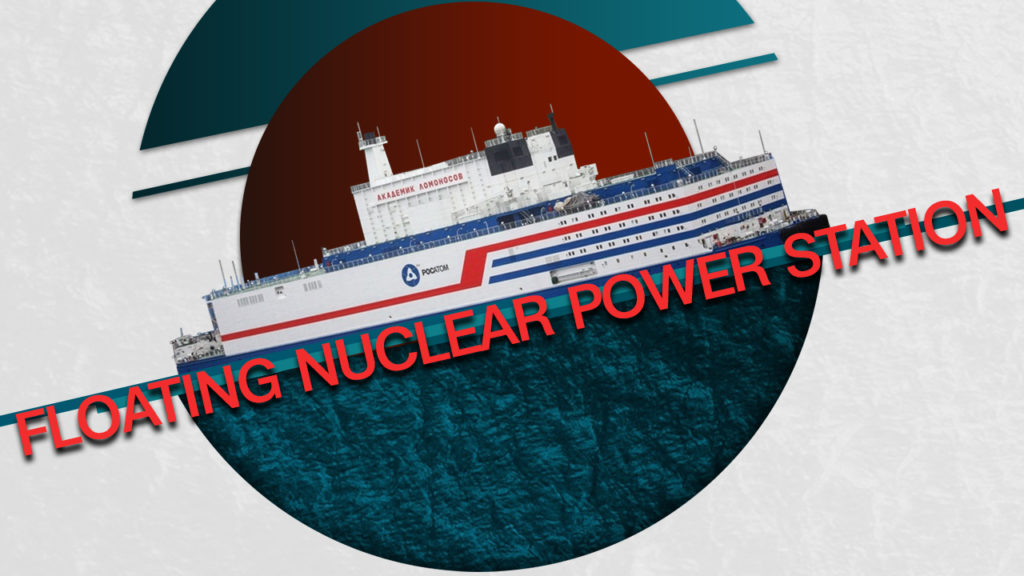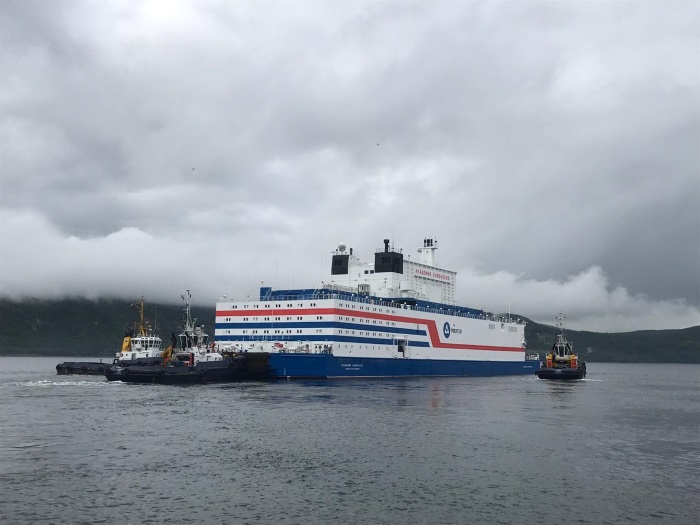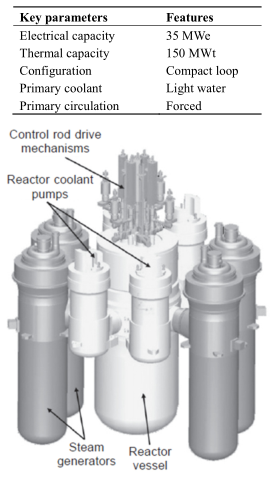On August 23rd, a ceremony took place that saw the start of the towing of the Akademik Lomonosov floating nuclear power plant from Murmansk to its permanent port in the city of Pevek, Chukotka. There, it will become a fully-fledged energy producing facility.
The command to start towing the Akademik Lomonosov floating power unit from Murmansk was given by the Director General of Rosatom State Corporation, Alexey Likhachev.
https://youtu.be/LWoM1kwYVUQ
https://youtu.be/b_3IB7Mp0y4
The floating nuclear power plant, with the help of tugboats, will cover a distance of more than 4700 km before being moved off the coast in Pevek.
After connecting to power grids there, it will essentially be used as a nuclear power supply unit, supplying electricity to the city of Pevek and the Chukotka Autonomous Region, including replacing the capacity of the Bilibino Nuclear Power Plant, which will be finally stopped in early 2020.
The Akademik Lomonosov floating nuclear power plant is the lead project for a series of low-power mobile transportable power units. It is designed to operate as part of a floating nuclear power plant (FNPP) in the Far North and the Far East and is a new class of energy sources based on Russian nuclear shipbuilding technologies. The FNPP is designed with a large margin of safety to counter external threats. The station is equipped with two KLT-40S icebreaker-type reactors that are capable of generating up to 70 MW of electricity and 50 Gcal/h of thermal energy in the nominal operating mode, which is enough to ensure energy consumption in a city with a population of about 100 000 people.
The Akademik Lomonosov has a length of 144 metres and a width of 30 metres. It has a displacement of 21 500 tonnes and a crew of 69 people.
Reactors were designed by OKBM Afrikantov and assembled by Nizhniy Novgorod Research and Development Institute Atomenergoproekt. The reactor vessels were produced by Izhorskiye Zavody. The turbo generators were supplied by the Kaluga Turbine Plant.
Its planned service life is 40 years. The operating time of reactor installations between overloads of the core is three years. All nuclear fuel and radioactive material handling systems are located inside the FNPP. The core reloading and storage of spent fuel is carried out on board the FNPP.
It can carry sufficient enriched uranium to power the two reactors for 12 years, before having to be towed, with its spent fuel, back to Russia, where the radioactive waste will be processed. In addition, such power units can operate in island states, and a powerful desalination plant can be created on their bases.
The energy sphere can easily be changed by the two generations of the FNPPs. The first generation is a massive engineering feat, with the second one being even more impressive.
This technology that could potentially provide safe and clean energy to a large part of the planet, which could also be provided at a cheap price.
Naturally, it doesn’t come without its critics. Akademik Lomonosov has come under widespread criticism from environmental groups such as Greenpeace and the Bellona Foundation. Greenpeace criticized the project as one that may cause harm to a “fragile environment which is already under enormous pressure from climate change,” as well as calling it a “nuclear Titanic” and a “Chernobyl on Ice.”
In response, Rosatom affirmed that precautions have been taken to prevent a nuclear disaster and that the floating plant meets all the requirements of the International Atomic Energy Agency.
Back in 2018, the New York Times wrote a report on the Akademik Lomonosov, citing Jacopo Buongiorno, a Professor of Nuclear Engineering at the Massachusetts Institute of Technology (MIT).
“They are light-years ahead of us,” Buongiorno said.
The construction of the FNPP was carried out by order of Rosatom in accordance with the Federal Target Program, “Energy Efficient Economy” for 2002-2005 and for the long term until 2010. Initially, on May 19, 2006, the winner of the tender for the construction of the FNPP of project 20870 was declared JSC Production Association Northern Machine-Building Enterprise (NSR, Severodvinsk).
On April 15th, 2007, the ceremony of laying the Akademik Lomonosov keel was held at the NSR, with a planned completion date of 2010.
However, then the management of the NSR stated the requirements for revising the contract terms and the cost of building the FNPP. As a result, in August 2008, Rosatom terminated the agreements with the NSR and transferred the construction of the FNPP to JSC Baltic Plant (then part of Pugachev’s United Industrial Corporation). In May 2009, the Akademik Lomonosov was reloaded at the Baltic Shipyard. At the same time, the contractual readiness of the FNPP was shifted towards the end of 2012, and its commissioning in 2013.
On June 30, 2010, the Akademik Lomonosov FNPP was launched in St. Petersburg at the Baltic Shipyard. However, only on September 27th and October 1st, 2013, steam generating units were loaded onto the FNPP. Under the terms of the new contract, the Baltic Shipyard pledged to hand over the FNPP, ready for towing to the place of operation, on September 9th, 2016.
On October 4th, 2016, the construction of the coastal infrastructure of the FNPP in Pevek (Chukotka Autonomous Region) began.
The towing of the completed Akademik Lomonosov FNPP from the Baltic Plant to Murmansk started on April 28th, 2018, and it arrived in Murmansk on May 19th and was moored at the site of the Atomflot FSUE (a subsidiary of Rosatom).
The loading of nuclear fuel into the first reactor (starboard) of the power unit was started there on July 25th, 2018, and into the second reactor (starboard) on September 28th. On November 2nd, 2018, the first PEB reactor was launched. The Akademik Lomonosov power station was officially cleared for operation on July 4th, 2019.
The State Atomic Energy Corporation, Rosatom is already working on the second generation of the FNPP – the Optimized Floating Power Unit (OFPU), which will be smaller and more powerful than its predecessor. It is supposed to be equipped with two RITM-200M reactors with a total capacity of 100 MW. There is no disclosed plan of how many of these FNPP will be produced. Currently, with the Akademik Lomonosov, Russia operates 11 nuclear power plants, with the Bilibino NPP planned to stop working in the early 2020s, the number would remain at 10, for a while.
The second generation is under development and in 2015 construction of a second vessel starting in 2019 was announced by Rosatom. In 2007, Rosatom signed an agreement with the Sakha Republic to build a floating plant for its northern parts, using smaller ABV reactors
Allegedly, Gazprom also plans to use 5 FNPPs for offshore oil and gas field development and for operations on the Kola and Yamal peninsulas. Other locations that these ships may be used at include Dudinka on the Taymyr Peninsula, Vilyuchinsk on the Kamchatka Peninsula.
According to Rosatom, 15 countries, including China, Indonesia, Malaysia, Algeria, Namibia, Cape Verde and Argentina, have shown interest in hiring such a device. It has been estimated that 75% of the world’s population live within 100 miles of a port city.
These are the locations which it would be useful – on the Northern Sea Route, in and around the Arctic. The floating nuclear power plants will solve the issue of the energy supply in the region and will allow to create a comprehensive support infrastructure along the Northern Sea Route.
Such nuclear power plants will also allow solve energy issues in the areas where the construction of classic nuclear plants is not possible (for example, because of a seismic hazard) or is too costly and complicated. This would help to supply the port cities of Sevastopol, Novorossiysk or Vladivistok with additional electricity.
African states suffer from constant energy shortages. In addition, as mentioned above, the ship may be equipped with a desalination plant, so it could also provide massive amounts of clean, drinkable water for the local population.
One more likely location is the Arabian Peninsula, some parts of Saudi Arabia suffer from energy shortages. The same goes for Yemen. Such a ship may be used to provide al-Hudaydah, for example, with energy and clean water, and of course if the Saudi-led intervention continues there, its security needs to be ensured.
Floating nuclear power plants can be used at river routes, for example in Russia and throughout Asia. Some United States cities in remote areas such as Alaska may also benefit, since until the US makes some adequate icebreakers, they would still need to ask Russia for assistance in a crisis.
Environmentalists are concerned that the floating plant could fall victim to a disaster like a tsunami, resulting in a possible nuclear catastrophe.
“It’s riskier than running an ordinary nuclear-power station, and Russia has a checkered past when it comes to ordinary power stations,” Jan Haverkamp, a nuclear-energy expert at the environmental nonprofit, Greenpeace, told Business Insider.
Haverkamp published a blog post that referred to the floating plant as “Chernobyl on Ice.” Haverkamp said he borrowed the phrase from an article published in the Finnish newspaper, YLE because he thinks Russia may be ignoring safety concerns about the plant.
It is not quite certain that these concerns are justified. The world ocean is a gigantic water mass, obviously. Even if the entire ship is to sink, the environmental impact would be much less than a conventional NPP having a “Chernobyl-style” failure. Water is infamous for swallowing up radiation with little to no adverse side effects.
It appears that the critics are disregarding many of the obvious facts that show the FNPP is actually quite a lot safer than the conventional NPP. Despite this, there is the HBO Chernobyl propaganda series, that attempted to present the Russian nuclear energy industry as one that cuts corners just to save money, at the expense of safety.
The starting of the towing of the Akademik Lomonosov FNPP is an important signal, showing that soon the energy industry may be changed on a global scale, thus, it is likely that the Western establishment will use all means necessary, and especially MSM and other channels of propaganda to influence opinions against the technology.
The truth is that if Russia can produce these ships fast enough, provide safer and cleaner energy, as well as drinkable water, that means its position would grow strongly, and its main competitor in the US clearly doesn’t wish to see that.











“Water is infamous for swallowing up radiation with little to no adverse side effects”. That’s utter, horrible rubbish. Radiation famously travels extremely far (see Fukushima) and contaminates, causes deformations etc. for a long time. Also, there is the problem of nuclear waste for which there is no solution.
Fukushima was an air born release, this is bad news in case of an accident.
Water is very dense and has a polar charge, much like a buffer, allowing it to slow down and absorb the charged particles (or take down their energy state) ?
No, its absolutely accurate. Alpha, beta and neutron radiation doesn’t penetrate water, neither does gamma to any great degree. Radionuclides are heavy and insoluble so don’t spread through water. Radiation from stricken nukes subs doesn’t propagate through the ocean is remains contained to the wreck sites, even where the sub is a scattered debris field like the US Thresher and Scorpion (which both imploded and lie at great depth).
Maybe you should have stayed at school and learned some physics?
Moron,
The atmosphere moisture has the same thickness, like 10 meters column of water.
and it protects us from all radiation, coming from sun and cosmos.
if you did not know this , then sorry for the moron,
if you try to make the propaganda, then I wish yo all the bad, and you are a big idiot.
Nice! With all that heat production they can have some nice underground greenhouses there and supply the whole region with fresh veggies! All the kids will hate the thing.
https://www.youtube.com/watch?v=iD9o0OWYHRo
‘Wohlstetter served as an inspiration for Stanley Kubrick’s film, Dr. Strangelove or: How I Learned to Stop Worrying and Love the Bomb. In 1962, Kubrick was looking for his next project after Lolita and started reading intensively on nuclear issues. One of Kubrick’s early ideas was to make a realistic thriller, titled after Wohlstetter’s “Delicate Balance of Terror”. But Kubrick could not conceive of a realistic scenario for an accidental nuclear war, so turned instead to the idea of making a comedy. While the character of Dr. Stragelove is a composite of numerous people associated with RAND (Dr. Strangelove confesses to the president having commissioned a study by “the Bland Corporation” of the possibility of a doomsday device) in the movie that was made, he is mostly based on Herman Kahn, John von Neumann, Wernher von Braun and Edward Teller.’ https://en.wikipedia.org/wiki/Albert_Wohlstetter
The same Albert Wohlstetter founder of the NeoCons wo ‘chaired the dissertation committees of Paul Wolfowitz, Efraim Inbar and Zalmay Khalilzad.’ The same Zalmay Khalilzad on whom Trump relied on to make peace with the Taliban – on this weekend in Camp David – and surprise, surprise – failed:
‘At the suggestion of Hans Morgenthau and with his help, Wohlstetter secured a position as a professor of political science at the University of Chicago.[23]
In the 1960s and 1970s, he expanded the scope of his research to include alliance policy and nuclear nonproliferation,[24] ballistic missile defense,[25] innovation in military technology,[26] peacetime military competitions,[27] and military potential and economics of civil nuclear energy.[28]
In the 1980s, Wohlstetter frequently criticized proponents of mutual assured destruction who supported targeting of nuclear weapons on civilians and cities instead over enemy combatants and military forces.[29]
Wohlstetter and his wife, Roberta Wohlstetter, also counseled both Democratic and Republican administrations, including advisers to President John F. Kennedy during the Cuban missile crisis in 1962.[30] They received the Presidential Medal of Freedom from Ronald Reagan on November 7, 1985.
The Commission on Integrated Long-Term Strategy meets with President Reagan to discuss their report, Discriminate Deterrence. Members of the Commission on the left side of the table (clockwise from the bottom of the photograph to the top): Gen. Bernard Schriever, former Commander, Air Force Systems Command; Judge William P. Clark, former National Security Adviser; Ambassador Anne Armstrong, Chairperson, President’s Foreign Intelligence Advisory Board; Gen. John Vessey, former Chairman of Joint Chiefs of Staff; Albert Wohlstetter; Fred Iklé, former Under Secretary of Defense for Policy; Zbigniew Brzezinski, former National Security Adviser; Gen. Andrew J. Goodpaster, former NATO Supreme Allied Commander; W. Graham Claytor, Jr., former Secretary of the Navy and Deputy Secretary of Defense; Samuel P. Huntington, Director, Center for International Affairs, Harvard University; Admiral James L. Holloway III, former Chief of Naval Operations (Commission members not present: Henry A. Kissinger, former National Security Adviser and Secretary of State; Joshua Lederberg, Professor of molecular genetics and informatics and President of Rockefeller University). The President and staff, right side of table, (top to bottom): National Security Adviser Colin Powell; President Ronald Reagan; Secretary of Defense Frank Carlucci (obstructed); Chief of Staff Howard Baker. White House Cabinet Room, Washington, D.C., 12 January 1988. Photograph by William Fitz-Patrick, courtesy of the Ronald Reagan Presidential Library. The Commission held a press briefing later that day at the Pentagon which is available via C-SPAN.
During his long career, Wohlstetter also taught at UCLA and the University of California, Berkeley, in the early 1960s. From 1964 to 1980, he taught in the political science department of the University of Chicago, and chaired the dissertation committees of Paul Wolfowitz, Efraim Inbar and Zalmay Khalilzad. He is often credited with influencing a number of prominent members of the neoconservative movement,[31] including Richard Perle (who, as a teenager, dated Wohlstetter’s daughter Joan).[32] He is the uncle of John Wohlstetter, author of Sleepwalking with the Bomb and The Long War Ahead and The Short War Upon Us.’
And since Wohlstetter made his carrière with the help of Hans Morgenthau, they where all in the pocket of Chabad – so nothing has changed -now, at the finale…
‘Morgenthau died on July 19, 1980, shortly after being admitted to Lenox Hill Hospital in New York with a perforated ulcer.[12] He is buried in the Chabad section of Montefiore Cemetery,[13] in proximity to the Lubavitcher Rebbe, with whom he had a respectful relationship.’
https://en.wikipedia.org/wiki/Hans_Morgenthau
Oh great another Russian nuke disaster coming up I see .
Hello again Mr.meme i see your butthurt is still strong damn that Russian whom raped you must have really done some damage XD
Your mommy was quite the butch .
uuuu so it seems he did do alot of damage ;)
Khazars, the Russians have eliminated you with the Schaschka sword, it will be the Iran that will take care of you with an atomic bomb in your head.
The only nuke disaster was Chernobyl, and it failed cuz inbred Ukropi trash were running the facility…
and it will always go your way, stupid ukrop yew.
It makes me happy to see you whine here.
Still making up new names for yourself solomon kupek.
It’s a great, far-sighted concept.
Nuclear power in one form or another is absolutely going to be needed.
Sorry, guys, windmills aren’t going to do it, if you want to always be able to turn a switch and have the lights go on.
And the flexibility of applications this ship offers opens all kinds of possibilities.
Russia jokes about nuclear power and the Burevestnik atomic missile incident does not make one feel comfortable.
‘cept whatever they were testing was not the Burevestnik engine. Maybe an RTG-type power supply for sea-bed installed missile canisters, maybe something else. The jury is still out…
Solomon kupek is the new alter-ego toronto tonto, get over it Israeli loser.